Summary
- Asian stocks had a tough start to 2022 amid concerns that persistent inflation could cause any tightening by the US Federal Reserve (Fed) to be more aggressive than expected. For the month, the MSCI AC Asia ex Japan Index fell by 3.10% in US dollar (USD) terms.
- North Asia saw mixed returns. China and Taiwan reported GDP growth in 2021 that exceeded expectations, while the People’s Bank of China (PBOC) loosened monetary policy to further shore up the economy. South Korea underperformed as the central bank raised its benchmark rate to curb inflation.
- The ASEAN region generally outperformed the broader index. The Philippines was the best performer, buoyed by faster-than-expected GDP growth of 7.7% YoY in the fourth quarter of 2021. Malaysia and Singapore saw more muted returns as rising inflation dampened sentiment.
- There is growing acceptance that the Omicron variant, although more infectious, is less virulent. Thus, fewer restrictions are likely to be put in place, implying that Omicron’s economic impact will be smaller compared to previous variants. We believe the best policy is to stick to a fundamental led bottom-up stock selection, seeking out companies undergoing significant positive fundamental changes that can deliver sustainable returns in the future.
Market review
Regional equities fall in January
Asian stocks had a tough start to 2022 amid concerns that persistent inflation could cause any tightening by the Fed to be more aggressive than expected. The central bank has primed investors for a first interest rate hike in March. For the month, the MSCI AC Asia ex Japan Index fell by 3.1% in US dollar (USD) terms, with markets in the ASEAN region generally outpacing their North Asian counterparts.
Chart 1: 1-year market performance of MSCI AC Asia ex Japan versus Emerging Markets versus All Country World Index
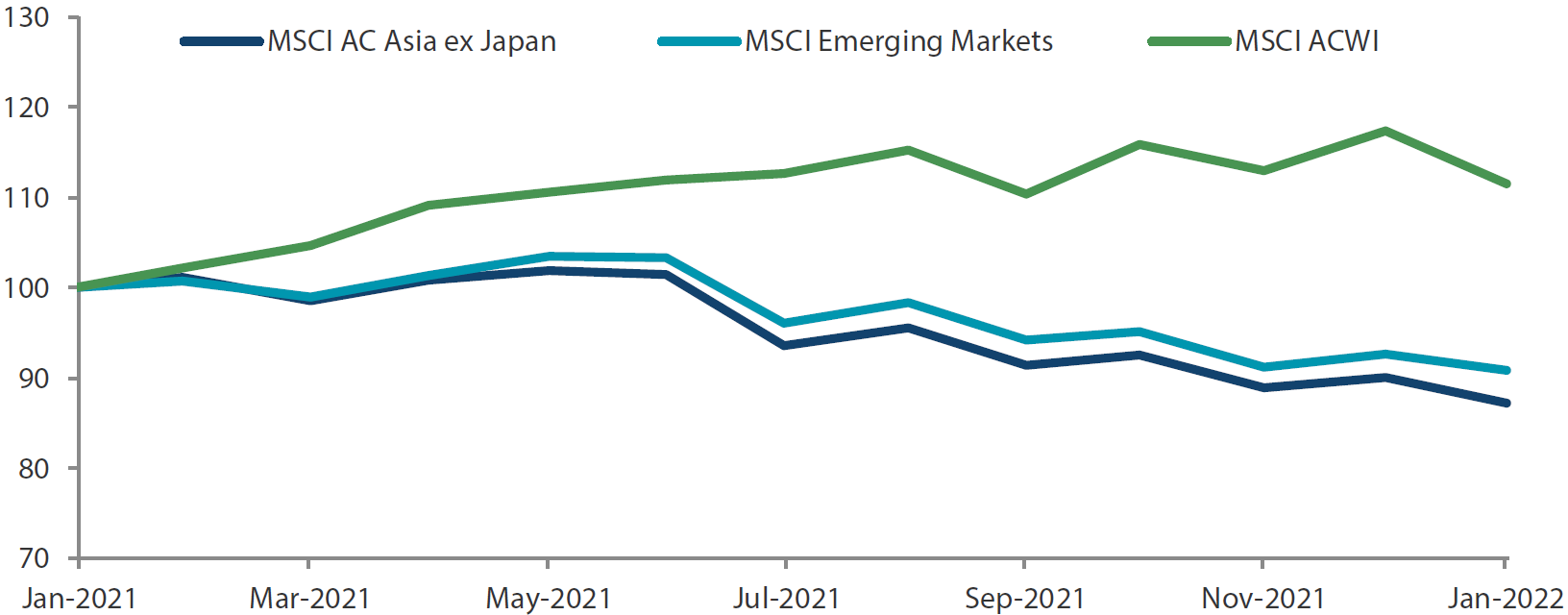 Source: Bloomberg, 31 January 2022. Returns are in USD. Past performance is not necessarily indicative of future performance.
Source: Bloomberg, 31 January 2022. Returns are in USD. Past performance is not necessarily indicative of future performance.
Chart 2: MSCI AC Asia ex Japan versus Emerging Markets versus All Country World Index price-to-earnings
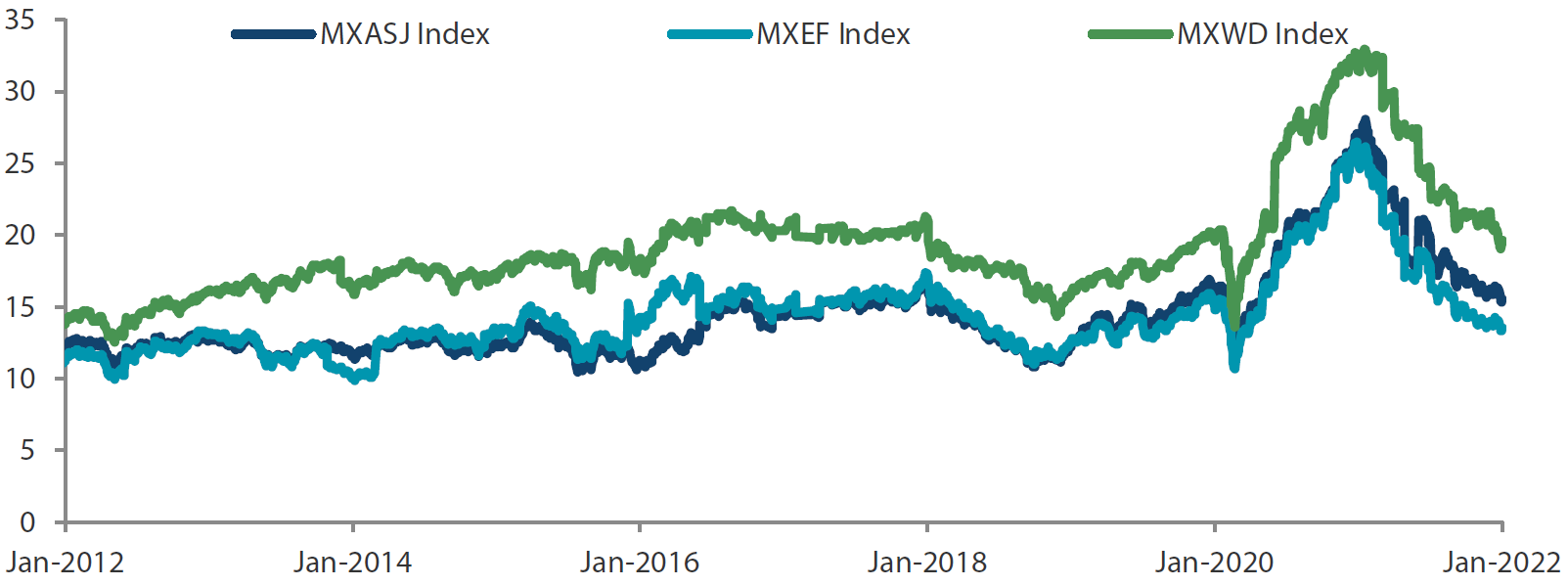 Source: Bloomberg, 31 January 2022. Returns are in USD. Past performance is not necessarily indicative of future performance.
Source: Bloomberg, 31 January 2022. Returns are in USD. Past performance is not necessarily indicative of future performance.
North Asia sees mixed returns
China (-3.0% in USD terms) saw its GDP grow by 8.1% in 2021, which was higher than expected, but its fourth-quarter growth slowed to 4% year-on-year (YoY) on the back of domestic COVID-19 outbreaks and continued weakness in the property sector. In contrast to the Fed and many other developed market central banks, the PBOC continued to loosen policy; it cut its one-year loan prime rate by 10 basis points (bps) to 3.7% and its five-year loan prime rate by 5 bps to 4.6%, in an attempt to further shore up the economy. Hong Kong gained 1.0% in January—the territory’s unemployment rate fell to 3.9% in the final quarter of 2021, although recently extended social distancing measures could cause joblessness to rise again.
Elsewhere in North Asia, South Korea (-10.2%) was the worst performing market in the region. South Korea’s central bank raised its benchmark rate to its pre-pandemic level of 1.25% to curb inflation, and kept the door open for further tightening. A resurgence of local COVID-19 cases, despite extended movement restrictions, also affected investor sentiment. Taiwan (-2.0%) edged lower on the back of weakness in its tech stocks. That said, its economy grew at its fastest pace in over a decade in 2021, buoyed by robust tech exports during the pandemic. According to preliminary data, Taiwan’s GDP growth reached 6.28% for the full year, compared to 3.11% in 2020.
ASEAN markets outperform except for Malaysia
The ASEAN region generally outperformed the broader index. The Philippines (+4.1%) was the best performer in the region, buoyed by faster-than-expected GDP growth of 7.7% YoY in the fourth quarter of 2021. Thai stocks (+0.2%) also edged higher, as the government approved a THB 3.19 trillion budget for the 2023 fiscal year and resumed a quarantine-free visa programme for vaccinated visitors. On the other hand, Malaysia (-3.6%) and Singapore (-1.1%) saw more muted returns as rising inflation dampened sentiment. Towards the end of the month, Singapore’s central bank unexpectedly tightened its monetary policy settings in an out-of-cycle move to counter rising prices.
Indian stocks decline
India declined by 1.4% in January. The country’s unemployment rate, which rose to a four-month high of 7.91% in December, remains a concern. However, the nation is expected to see economic growth of 9.2% for the year ending March 2022, helped by vaccine rollouts and a reduction in COVID-19 infections. Policymakers also announced the annual Union Budget, which made provisions for a sharp increase in public investment and infrastructure spending.
Chart 3: MSCI AC Asia ex Japan Index¹
| For the month ending 31 January 2022 | For the year ending 31 January 2022 | |
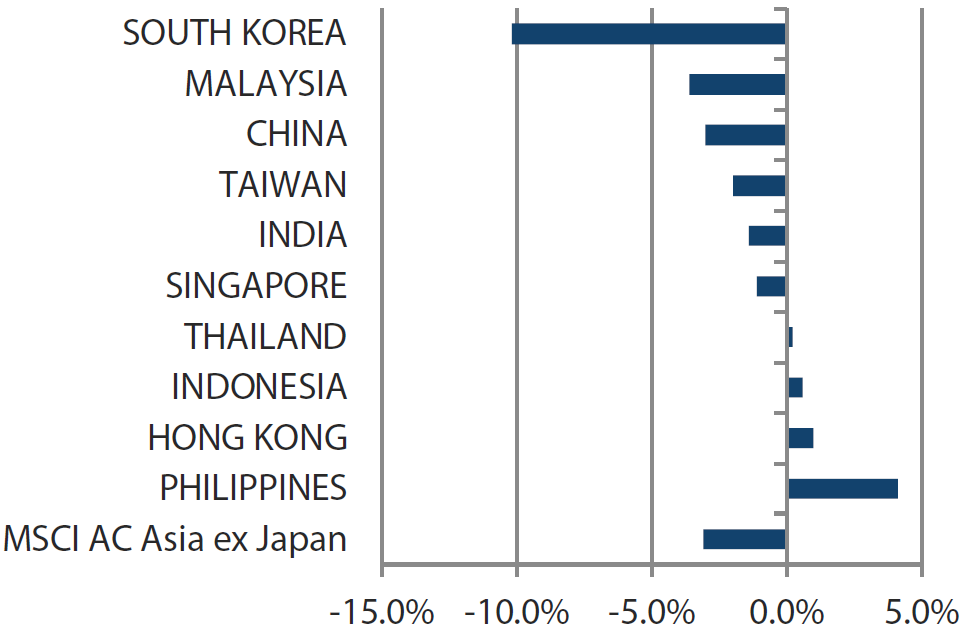
|
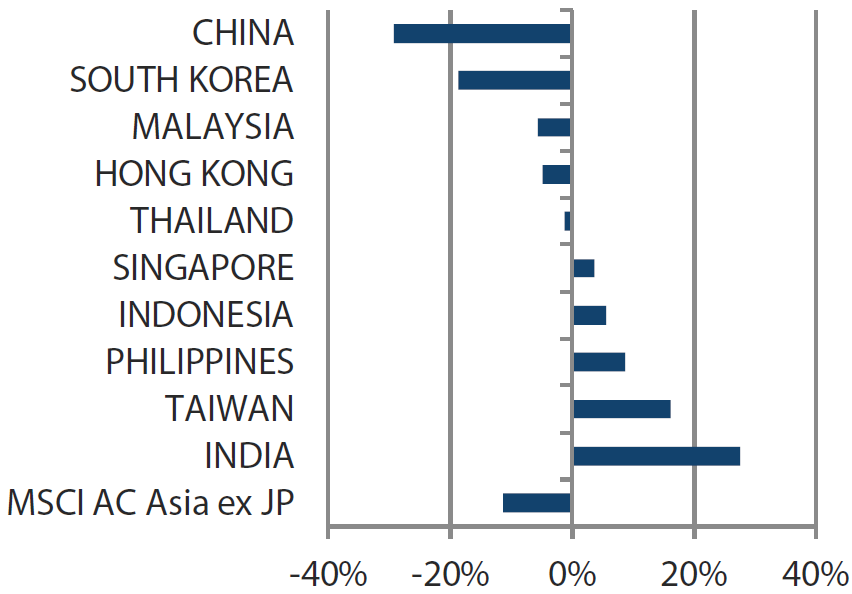
|
Source: Bloomberg, 31 January 2022.
¹Note: Equity returns refer to MSCI indices quoted in USD. Returns are based on historical prices. Past performance is not necessarily indicative of future performance.
Market outlook
Lean on disciplined stock picking approach to navigate uncertain conditions
There is a growing consensus that the Fed will hike rates at least four times in 2022, and perhaps even five times, with some form of quantitative tightening also likely to be announced. There is also growing acceptance that the Omicron variant, although more infectious than others, is less virulent. Thus, fewer restrictions are likely to be put in place, implying that Omicron will have a smaller impact compared to previous variants. As these views percolate through the market, equities are expected to find a bottom. Through this transition and beyond, individual stocks with strong fundamentals and attractive risk-reward trade-offs are likely to prove winners, be they in the “value” or “growth” camp.
Focus on longer-term economic drivers in China
The shift in the Chinese government’s focus toward stability implies some form of monetary easing is likely to persist for the better part of 2022, if for no other reason than to offset the negative economic impact caused by a zero-tolerance COVID-19 policy and its clamp-down on the profligacy in the property sector, and to smooth the way ahead of the 20th Party Congress. This implies that some pockets of the economy will fare relatively better, especially those aligned to the broader economic imperatives of the nation such as building greater self-sufficiency in technology, “common prosperity” and decarbonisation. Our views are aligned with these longer-term drivers.
Remaining watchful in India
In India, the focus is on the latest annual budget, through which the government aims to develop domestic capacity and capability by boosting investment in infrastructure and job creation. This is especially necessary, in our view, given that activity has been sporadic on this front over the past few years. That the government seeks to achieve this while improving the country’s fiscal position raises some questions. With stock valuations relatively expensive, at least some of the optimism regarding an economic rebound appears priced in. Thus, we remain watchful, especially in the financial sector which ought to be the earliest beneficiary of any positive growth surprises.
Focus on technology in Taiwan and South Korea
The gradual “normalisation” of global supply chains is particularly critical for the technology sector. The easing of chip shortages, the secular growth of digitisation and the ever-rising need for greater computational power augur well for companies in South Korea and Taiwan, both in the near and longer term. While “Metaverse” is still in its early days, it is expected to be transformative for the semiconductor supply chain in the years to come. As such, we continue to favour integrated circuit design, content enablers and industrial tech.
Selective in ASEAN
Our preferences within the ASEAN region remain largely unchanged. While the pandemic has accelerated digitisation across the region as a whole, politics and relative over-reliance on tourism and oil leaves us unenthused in Thailand and Malaysia. Indonesia and the Philippines show better promise in multiple sectors, although the slow pace of reforms in the former, and presidential elections in the latter, bear watching. Singapore, which enjoys better corporate governance, remains a proxy for regional growth.
Chart 4: MSCI AC Asia ex Japan price-to-earnings
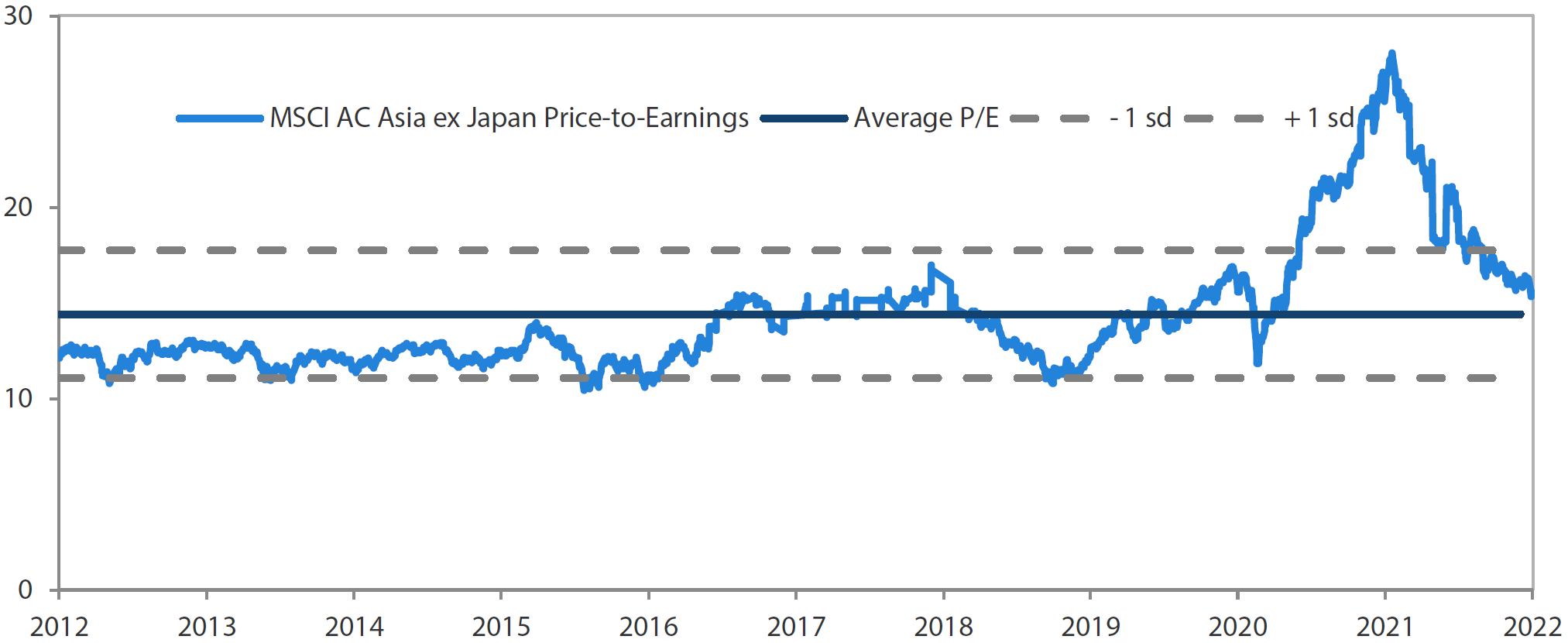 Source: Bloomberg, 31 January 2022. Ratios are computed in USD. The horizontal lines represent the average (the middle line) and one standard deviation on either side of this average for the period shown. Past performance is not necessarily indicative of future performance.
Source: Bloomberg, 31 January 2022. Ratios are computed in USD. The horizontal lines represent the average (the middle line) and one standard deviation on either side of this average for the period shown. Past performance is not necessarily indicative of future performance.
Chart 5: MSCI AC Asia ex Japan price-to-book
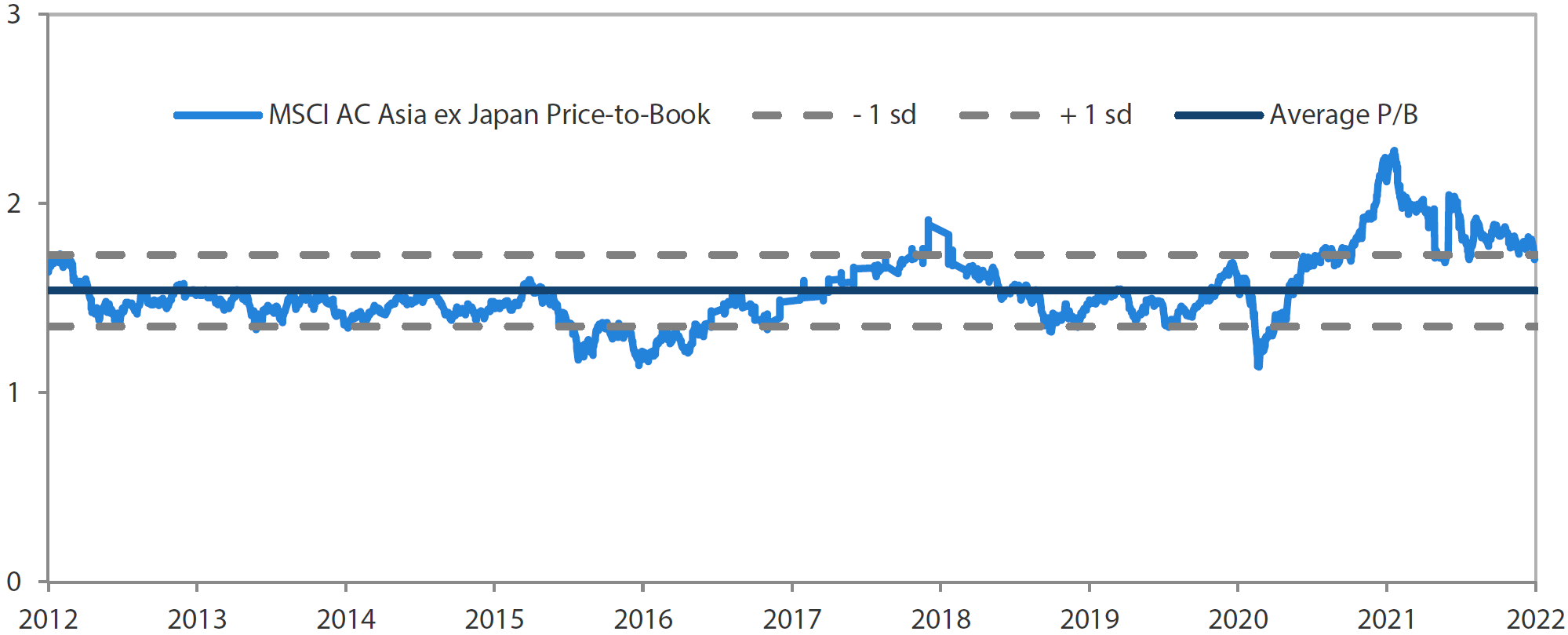 Source: Bloomberg, 31 January 2022. Ratios are computed in USD. The horizontal lines represent the average (the middle line) and one standard deviation on either side of this average for the period shown. Past performance is not necessarily indicative of future performance.
Source: Bloomberg, 31 January 2022. Ratios are computed in USD. The horizontal lines represent the average (the middle line) and one standard deviation on either side of this average for the period shown. Past performance is not necessarily indicative of future performance.




